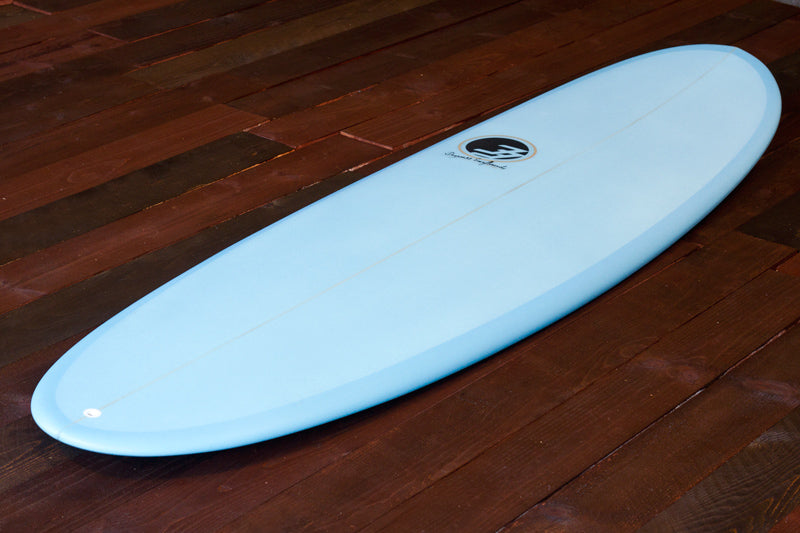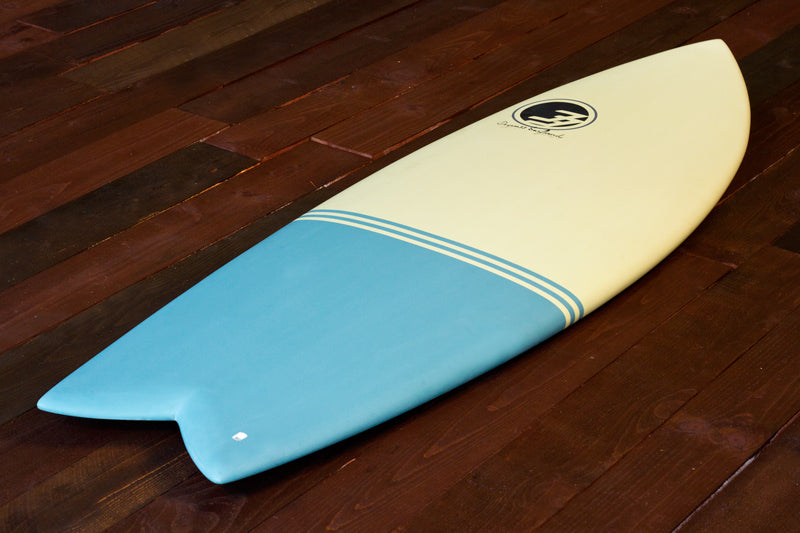Surfboard Guide - Poly vs Epoxy
Which construction do I choose?
So why all the talk about new technologies for surfboard construction?
Well, as you may or may not know, in December of 2005, Clark Foam, the industry leader in poly foam blank production, unexpectedly closed its doors. From that point on shapers everywhere have been experimenting with everything to come up with an alternative to the gaping hole that Clark Foam left in the industry.
By experimenting with other types of foam and resin, like eps and epoxy, shapers have developed a way to make an even lighter and tougher board! Up until the close of Clark Foam, Poly boards dominated about 90% of the market.
Because of this, the question you have to ask yourself today is if you want a Poly or Epoxy board. Let's break the two choices down.
POLY Construction:

Uses traditional construction of polyurethane foam, fiberglass cloth and polyester resin. Poly boards are reinforced with a wooden stringer that runs down the middle of the board. The final product is a board with a dense core and thin glass yielding basically a soft flex.
Surfers who ride poly feel that these boards are more responsive even though they have a little extra weight. (They tend to be about 10-15% heavier on average) They are known for their ability to really “dig in” to the wave to get clean carving turns.
Here's the beauty of a poly board though, it just feels good. We know thats a little abstract but it's the truth. When you hold a hand shaped poly board, there's just something about the purity of it. It's like you can sense all those who came before you oozing out of the board.
There are a few downfalls to poly boards however.
First of all, due to their soft flex, they are more prone to heel dents in the deck (the top of the board). This is essentially a pressure dent from pounding your foot or knee down, either when standing or wiping out. Most surfers feel that the soft flex and the way it performs is a great tradeoff for putting a few dents in it.
If you scrape the wax off of a used poly board, you will likely find many pressure dents regardless of the surfer’s ability. It’s just part of the deal.
Another thing to be aware of with a poly board is the way it “ages.” The polyester resin yellows from the sun. This results in faded colors, and a very “used” look. This may not make a difference to you if you like the way the board performs!
Additionally, Poly construction requires use of toxic VOC’s (volatile organic compound) from not only the resin, but the chemicals used to clean, dilute, and work with it.
Despite these negatives, its soft flex and construction have allowed poly boards to dominate the market for years. They have been well tested and refined on boards of every size and shape, and cater to surfers at every level.
Finally, let’s talk about the price of these boards. Obviously there are many factors when determining the price of a surfboard. (i.e.: Length, Shape, Graphics, Customization etc.) The general cost for a poly shortboard at a surf shop would be anywhere between $600-$900. For a longboard expect to pay $900-1300.
Since we’re our own shop with just a handful of employees, we can offer you a poly surfboard at the low end of the price spectrum, built right here in the U.S.A. by legendary shaper Bill Minard. We can make poly boards in any shape you dream up!
EPOXY or EPS Construction:

Epoxy boards are a combination of polystyrene foam, fiberglass cloth, and epoxy resin, typically resulting in a lighter and more durable surfboard! Unlike the wooden stringer that is always used in a poly board, epoxy's may or may not use a wooden stringer. Instead, many EPS boards use either a dense stringer material (typically PVC) that reinforces the board’s strength while still maintaining its light weight characteristics, or they won't use a stringer at all because of the strength and stiffness of epoxy resin.
EPS stands for “Expanded Polystyrene.” This is open-celled, beaded foam, which is used in everyday items such as cups, beer coolers and car seats. As the name (“expanded polystyrene”) implies, EPS foam is expanded into a mold to ultimately end up with a finished surfboard blank at a specific density.
Don’t get me wrong though. We’re not saying that EPS boards are built by filling up a mold; the mold is simply a starting block of foam in which surfboards can be shaped from. This allows shapers to create high tolerance molds of EPS to cut surfboard blanks out of.
Epoxy boards are some of the lightest and strongest on the market because of the stiffer resin and less dense foam but have a very unique feel under foot. The stiffer resin gives it a more lively (stiffer or faster) flex pattern resulting in what some surfers refer to as a snappier feel. The foam produces what feels like a “floatier” board because of the increase in buoyancy.
EPS boards feel more on top of the water, paddle faster (as long as it's not choppy), and many say are able to gain more speed from the wave. These three elements alone are enough to make an epoxy board a hit with surfers of every ability level.
Another benefit of epoxy boards is that they are more environmentally friendly with less toxic VOC’s and can be cleaned with denatured alcohol.
Just like with poly boards, epoxy has its own set of drawbacks. The open-cell beads can present a problem if the board is cracked because it has extra space between beads, allowing water to get in. To prevent this from happening, if you damage your surfboard, simply get out of the water and apply a little Solarez (ding kit) to seal the problem area.
The other drawback to epoxy is its sensitivity to sunlight. Heat and UV can cause a great amount of damage to any epoxy board. As the heat and UV react with the materials of an epoxy board the board will expand and can delaminate if not taken care of. The easiest way to combat this issue is with a reflective bag, especially if you’re going to have your board in direct sunlight for a while. If you’re just going back and forth to the beach to surf, and your board is in the water or the house the rest of the time, you should be just fine. Keep in mind we’ve seen boards get damaged in as little as 30 minutes in intense sun.
Not all surfers are sold on the way they perform. Pro surfer, Rob Machado said, “There are no disadvantages to epoxy in under head-high waves.” “But epoxy is less responsive in overhead waves, a way different feel.”
What Rob is referring to is the other side of the materials used. Some surfers report that epoxy boards are too stiff, or that they provide inconsistent feedback because they can bounce when the water gets choppy. They can also be tougher to paddle in less than ideal conditions because of the same thing. Instead of cutting through the chop, they can sort of bounce around a bit.
Lastly, many people are concerned that such a tough board with little flex would snap easily if tested. Never forget that regardless of what your board is made of, any board can break. Shapers and glassers do their best to make a board that is super tough, but one that also has flex. To achieve both of those things is an art. Breaking boards is not a common occurrence but it does happen. Don’t forget, the ocean is powerful and boards are susceptible even when it's not pumping.
The demand for our surfboards in epoxy construction has given us the opportunity to take our production to the next level, in turn, dropping the cost of materials by buying in bulk. Where epoxy boards used to cost more than poly, they are now our best bargain. This is the best option for getting started with surfing. You’ll find epoxy shortboards selling in shops for $500-$700 and longboards for $700-$1000. We can save you HUNDREDS of dollars with ours.
Conclusion
The moral of this story is that you will probably gravitate to one or the other. If you are brand new to surfing we personally would recommend standard epoxy for the simple fact that they are durable and surf great. If you're ready to step up your game and go custom choose Poly construction. Both are great!



